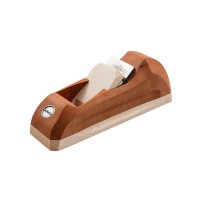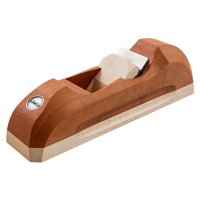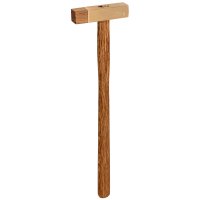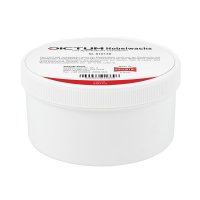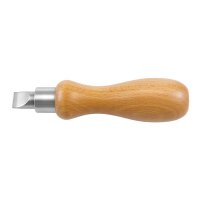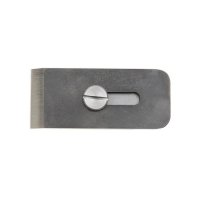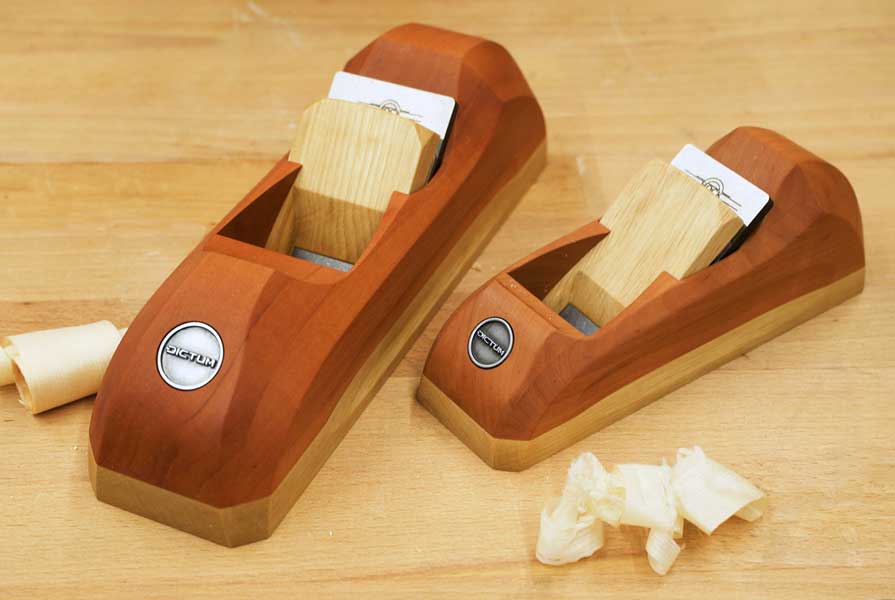
In the smoothing process, rough and uneven surfaces and edges are planed flat. To be able to follow the grain optimally, it is important that the planer is guided as close as possible to the workpiece. DICTUM Low Planes are made for this due to their low design. Without annoying handles, you can quickly adjust your hand position to the conditions and easily shift the pressure point of the plane. Depending on the grain, you can push both DICTUM Low Planes like a classic plane or use them on tension like a Japanese plane. The low weight makes the Low Planes effortless to guide and easy to reposition on the material. The curved shape of the planer box provides direct contact with the surface.
DICTUM® Low Plane Finishing Plane
With a weight of 600 g and a blade width of 45 mm, the DICTUM Low Plane is ideal for finishing larger surfaces and longer edges. As usual for finishing planes, its cutting angle is 45°. With an overall length of 235 mm and indentations on the sides, the DICTUM Low Plane can be easily gripped and guided with two hands. A mould in front of the plane opening provides a secure rest for the thumb of the front hand, so that the plane opening is not held shut unintentionally.
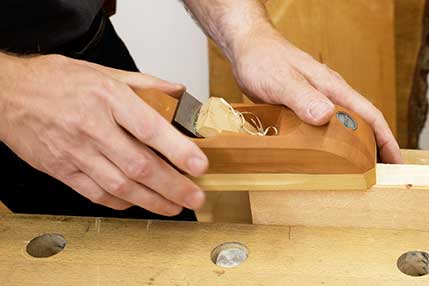
The DICTUM® Low Plane Smoother is pushed or pulled with both hands.
DICTUM® Low Plane One Hand Smoother
The DICTUM® Low Plane One Hand Smoother with a blade width of 39 mm is the little brother of the finishing planer. Weighing only 360 g, this compact plane is ideal for finishing small surfaces and curved components. Due to its short design, with only 165 mm, you can easily guide it with one hand. It is therefore also suitable for edge processing and chamfering. The slightly shallower cutting angle of 40° also allows end grain to be cut.
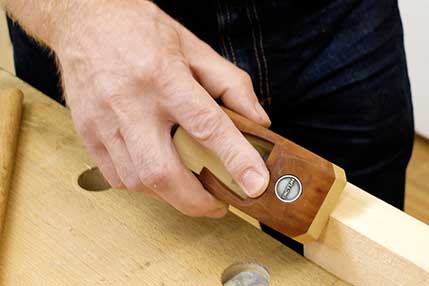
Ideal for bevelling, the DICTUM® Low Plane One Hand Smoother
Design
Planes have been known since Roman times. These so-called »Roman planes« had lateral openings in the body of the plane which served for cross handles. Until the Middle Ages there were many planes without handles north of the Alps. It was not until the 17th and 18th centuries that most planes in Europe were equipped with two handles, a planer knob at the front and a hand guard at the back. In 1975, the cabinetmaker James Krenov favoured a type of wood plane without handles and described it in detail in one of his books. This is why this type of hand plane, which the DICTUM Low Planes are also based on, is still often referred to as the »Krenov plane«.
Plane iron
The 4.8 mm thick plane irons from Hock Tools are equipped with an additional cap iron. This reduces the vibration when working and thus ensures an exceptionally smooth cut. For sharpening, you can easily remove the cap iron with a screwdriver for cap irons. The high-purity carbon steel used has an excellent edge life with a hardness of approx. 62 HRC. The proportion of chromium and vanadium additives is less than 0.5 %, which makes the cutting edge exceptionally sharp to grind out and easier to restore than with conventional high-alloy tool steels. The plane irons are supplied sharpened ready for use and honed with a micro-bevel.
Adjusting the plane
As usual with other wood planes, both DICTUM Low Planes are adjusted by hammer blows. The plane body is recessed at the side in the iron area to simplify the adjustment of the plane iron. The parallel position to the plane sole (lateral position) is adjusted with lateral blows against the plane iron and the thickness of the shaving is adjusted by blows on the iron end. To retract the iron or reduce the thickness, strike the rounded end of the plane box diagonally (do not strike the plane sole!). The blows are thus made exactly in alignment with the plane iron, making it very easy to withdraw or release the iron. After each adjustment, whether the plane iron is set forward or back, you should fix the wedge again with light blows.
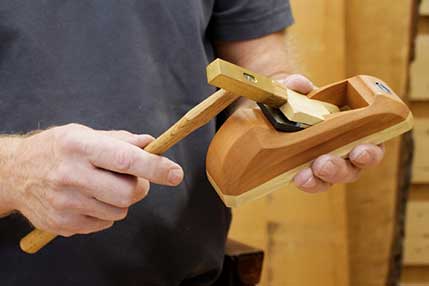
A combined setting hammer is gentle on the plane blade and the box.
By using a combined adjusting hammer, with striking surfaces made of wood and brass, you will protect the planer box and plane iron when adjusting.
Planer tuning
Both DICTUM Low Planes are delivered ready for use, so you can use the planes directly as finishing planes without any further preparation. If you want to use the DICTUM Low Planes as a smoothing plane for finest surfaces, we recommend the following adjustments:
Pulling off the planing blade. The plane blades of the DICTUM Low Plane are already sharpened and honed. Their mirror side is also perfectly flat and requires no further processing. To optimise the sharpness, you can still sharpen the micro-bevel of the plane blade on a fine sharpening stone (e.g. Shapton Glass Stone HR, Grit 8000).
Position the cap iron precisely. The cap iron, also called lever cap, should be positioned about one chip thickness behind the cutting edge of the plane blade. Since very thin chips are removed during cleaning, the chipbreaker should sit exactly parallel just a few tenths of a millimetre behind the blade.
Trueing the plane sole. As with most wood planes, the plane sole of DICTUM Low Planes is trued in the relaxed state. By driving in the wedge, it curves minimally so that no very thin shavings are taken off. To be able to plane very finely when cleaning, clamp the plane or drive in the wedge as for working, but leave the plane iron about 0.5 to 1 mm behind the plane sole. Hatch the plane sole with pencil marks. Now move the clamped plane in planing movements over a piece of sandpaper (e.g. Self-adhesive Abrasive Paper) that is clamped on a flat surface (e.g. machine table, granite slab or glass pane). When all pencil marks have disappeared, the plane sole is perfectly dressed for even the finest shavings when cleaning. Afterwards, wax the sole with Wax for Planes ein.

